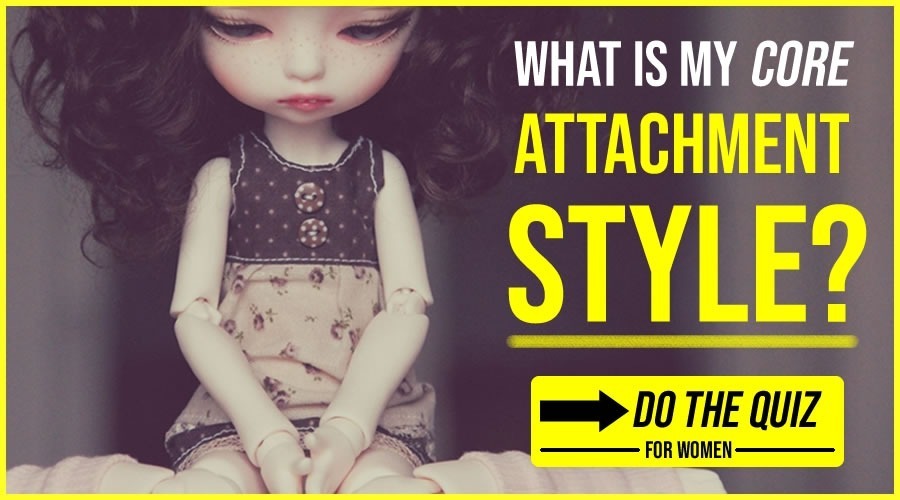NCRW
Dismissive Avoidant Attachment: What Is It & 7 Obvious Signs
Author: Paul R. Brian & Renée Shen
The attachment styles is a framework that describes the typical patterns in which people give and receive love in relationships.
The attachment styles are divided into two main categories: insecure attachment and secure attachment.
Dismissive avoidants fall under the insecure attachment category.
Dismissive avoidant attachment consists of people who desire emotional distance and a high level of independence in relationships.
They fear too much emotional and physical intimacy, often because of wounds and neglect that occurred in their early years.
Dismissive avoidant individuals tend to become stifled and avoidant when they get close to people.
Interestingly, the partner of an avoidant could desire a totally healthy amount of intimacy, but the avoidant will still feel repelled by it.
(Why is this important? It is because your core attachment style largely dictates and influences what happens in your relationship. Thus it’s imperative you understand your core attachment style!)
Table of Contents
What Is Dismissive Avoidant Attachment?
Dismissive avoidant attachment manifests differently in every person, but is generally characterized by:
- A fear of opening up to fully trusting and loving another person; and
- A general avoidance of intimacy (and that’s all kinds of intimacy, not just sexual intimacy)
Recommended: Fearful Avoidant Vs Dismissive Avoidant: Differences & FAQ.
As I wrote, the roots of dismissive avoidant attachment are usually found in early childhood.
It is a type of relational pattern that develops due to insufficient nurturing and responsiveness from caregivers starting from infancy.
It can also be linked to sexual or psychological abuse, but doesn’t have to be.
Our attachment styles aren’t random. They are connected to the way we were raised and the experiences we had in infancy and later on, childhood.
When it comes to the dismissive avoidant individual, they see themselves as self-reliant and invulnerable.
They experience feelings associated with being intimately connected to others as a threat or a weakness that could hurt or “expose” them.
People like that tend to repress and hide their feelings. They deal with emotions by distancing themselves and lying to themselves about what they are feeling.
People with this style of attachment have mixed feelings about intimate relationships in the best case scenario.
In the worst case scenario, they may have no feelings at all, due to completely detaching from their innate human need for closeness and intimacy.
On the one hand, they do wish to have emotionally and physically intimate relationships deep down inside.
On the other hand, they tend to feel uncomfortable with emotional and physical intimacy when it is asked of them.
They are well known as the type of people who flee when relationships get too close, intense or long-term.
These conflicted feelings are combined with, sometimes subconsciously, negative opinions about themselves and their partners as well as low self-esteem.
If you’re wondering why dismissive avoidants may have negative opinions about themselves, consider this:
If as a baby and child you felt scared and lonely (like babies do), and you cried out for warmth, safety and affection but you were repeatedly ignored, what would happen inside of you?
You would likely develop a subconscious belief that you’re not worthy of love.
So although people with dismissive avoidant attachment seem to act like they’re “above” all that intimacy stuff, and though they tend to be critical of others, it’s not actually because they truly feel superior.
Rather, it’s because they secretly feel unworthy.
7 Obvious Signs of Dismissive Avoidant Attachment
1. An Intense Fear Of Being Abandoned
Avoidance of long-term relationships because of an intense fear of abandonment is one of the main signs of insecurity in love and it’s a primary indicator of dismissive avoidant attachment.
In fact, it is the starting point for confirming or denying this pattern of behavior.
MORE: 15 Shocking Signs Of Abandonment Issues In Adults.
A normal fear of intimacy and getting too close may crop up from time to time. But an intense obsession and paralyzing focus on what could go wrong in love is often the sign of a dismissive avoidant attachment that goes much deeper.
In order to avoid the potential pain of being abandoned (which dismissive avoidants expect will always happen to them), the dismissive avoidant individual avoids relationships altogether and does not give his or her heart away.
The dismissive avoidant individual will tend to have many justifications for not being in relationships, including believing they are not good enough or just haven’t met the right person.
Whether or not it’s true to some degree that they haven’t met a good match, they will always seem to find a new reason why a long-term relationship isn’t possible.
2. An Overwhelming Need For Independence & ‘Space’
Dismissive avoidant attachment often manifests when the person prefers to perform most activities alone and needs a larger than usual amount of independence.
If they do have relationships, they are often strained by this constant need to be alone.
An interesting thing that happens with dismissive attachment is that it develops through contrast.
Although the person is afraid of abandonment as I mentioned in the previous point, this does not prevent them from manifesting an excessively independent attitude in the relationship.
In other words, they really don’t want to be left behind or end up alone, but often don’t realize they are leaving their partner behind and creating unnecessary space in the relationship.
This behavior begins in childhood and extends into adulthood, with almost identical results.
For example, the person with dismissive avoidant attachment can:
- Make decisions without consulting the opinion of the partner
- Hide or even reject displays of affection
- Assume a distant or cold attitude
Independence in the dismissive avoidant person develops as a self protective mechanism against insecurity and fear of rejection and abandonment.
But ironically, this sense of detachment and excessive need for independence often makes the non-avoidant partner leave the dismissive avoidant partner.
In other words, the very thing the avoidant person fears (abandonment) is exactly what their behavior inspires people to do to them: abandon them.
It’s a vicious cycle to say the least.
Recommended: 8 Signs An Avoidant Loves You & How To Inspire More Of It.
3. Difficulty Trusting Others
Trust is a central pillar in any relationship.
The reason why many relationships end is due to the lack of trust between the parties, because insecurity can prevent you from being able to trust your partner.
This is especially true with dismissive avoidant attachment style.
Sooner or later the dismissive avoidant individual’s inability to trust his or her partner will end up affecting the relationship in various ways.
Some specific examples of lack of trust are: doubts about your partner's loyalty, or believing they are cheating when they’re not.
Remember that, in very simple terms, trusting means tolerating uncertainty.
But dismissive avoidant people trust their own detachment rather than intimacy (or relationships in general).
More securely attached people (which is about half of the world’s population according to scientific studies) are reasonably resilient in the face of uncertainty.
However, the dismissive avoidant person cannot deal with this uncertainty well, because their nervous system is conditioned to avoid it completely.
If they were to confront the emotions they feel when they get close to people, they would feel too anxious (which is then heading into the territory of anxious attachment style or anxious preoccupied attachment style).
For the dismissive avoidant person, this distrust often leads to their relationships ending badly.
Or they drive their partner mad because nothing can seem to melt their walls and cause them to trust intimacy and connection.
Of course, not all people with dismissive avoidant attachment style are destined to be abandoned.
Some truly warm and connected people who are securely attached can actually handle an avoidant’s peculiar ways. These saintly people may miraculously be able to get through to the avoidant and build a genuinely trusting relationship over time.
4. A Desire For The Relationship To Be Perfect
Due to the fact that the dismissive avoidant person doesn’t understand intimacy and isn’t pulled to strive for it, the idea of perfection acts as a stand-in for real intimacy.
Of course, this desire for the relationship to look and seem perfect is also one of the signs of insecurity in love that can be inspired by the romantic conception inherited from society.
MORE: How To Make An Avoidant Miss You: 10 Proven Ways.
Many tend to idealize love in an extreme way, adopting the ideas presented in some films, series and commercials.
Some even pretend that the relationship is perfect at times, in order to maintain their ideal mental image.
But when some aspect of the relationship doesn't agree with the dismissive avoidant individual’s expectations they tend to get very upset.
They idealize and seek perfection as a form of subconscious sabotage, often looking for any justification why the relationship is not good enough or will let them down in the end, justifying their emotional distance.
5. Obsessive Comparisons To Previous Relationships
If you constantly compare your current partner to the previous one in a negative way, the relationship can deteriorate pretty quickly.
That’s common knowledge, because living in the past is a one way ticket to a breakup.
But dismissive avoidant attachment individuals often do this in a negative sense.
They do it to find parallels and associations that make them suspect that their current relationship is going in the same direction.
Comparing everything they do today with what they've done with someone else in the past will never end positively, and is yet another one of the subconscious sabotage techniques that dismissive avoidant individuals use to stay far away from love.
6. Frequent And Intense Jealousy
Now, most people won’t expect this sign on a list of signs of dismissive avoidant attachment style.
In some cases, extremely avoidant people can actually be on the other extreme:
Instead of feeling jealous, they’ll be happy that someone else is taking some of the responsibility off them for relating to their partner, rather than exploding in jealousy.
Not only that, but some avoidants will shut off to feelings of jealousy.
But here’s the truth:
Avoidants do get jealous! This is because whenever they do get close to someone and experience the vulnerability of intimacy with them, this “exposes” them.
They may be used to detaching from feelings, but by getting closer to a partner, it can actually sometimes activate their emotions.
This in turn brings up their innate low self worth and then feelings of intense jealousy ensue.
So:
Yes, jealousy is another of the signs of insecurity in love and therefore one of the main characteristics of a person with dismissive avoidant attachment.
It seems like almost anything sets them off.
Of course, a little bit of jealousy is normal, but this is no excuse for the manifestation of pathological and toxic jealousy.
Being jealous of one’s partner on a recurring basis is a symptom of insecurity and toxic traits.
The dismissive avoidant individual wants everything to be kept under their strict control in order to avoid disappointment and pain, so they often use jealousy as a tool to achieve this.
Needless to say, such excessive jealousy is a harmful thing that sooner or later ends up poisoning the relationship.
7. They Turn Minor Conflicts Into Serious Fights
Another one of the signs of dismissive avoidant attachment is a tendency to turn small disagreements into major fights.
This is due to the fact that dismissive avoidants cannot really be present with the emotions of their partner, and nor are they good at being present with (or noticing) their own emotions.
Instead of hearing their partner out and working towards greater connectedness with their lover, an avoidant can sometimes explode in anger or stonewall instead.
MORE: 20 Deadly Signs A Man Has Anger Issues.
An avoidant’s equilibrium is not likely to be rooted in closeness and warmth in a relationship, but rather, in behaviors that push people away.
And this is especially true in the fact of conflict - they just cannot deal with it.
The dismissive avoidant individual will find any topic or issue to use as an entry point for an argument or fight of some kind.
Yet again, this is a way to subconsciously sabotage and try to control the relationship.
The twisted logic is this:
If the dismissive avoidant individual is the one who ruins it, that will subconsciously “verify” their inner belief from childhood that intimacy is dangerous, overly confronting and not worth it.
How Can You Tell If Someone Is Dismissive Avoidant?
People with dismissive avoidant attachment style tend to relate strongly to the following statements:
"I feel best alone and without having an intimate relationship with someone. Relationships are dangerous and you only get your heart broken.”
“What matters most is being independent so I can protect myself from the cheaters and bad people out there.”
“God forbid I have to depend on others or someone has to depend on me! That sounds like a nightmare.”
“I really want to have a serious relationship with someone, sure. But I find it difficult to trust others completely, or create a bond of real intimacy. There’s just always something wrong!”
"I'm the one who's going to get hurt if I open up too much to someone!"
These proclamations are all possible signs of dismissive avoidant attachment.
If you relate to many of these statements or they apply to someone you care about, there’s a high chance you have at least some of the traits of somebody with a dismissive avoidant attachment style.
Frequently Asked Questions On Dismissive Avoidant Attachment Style
How Dismissive Avoidant Attachment Affects Relationships?
This type of attachment is characterized by the presence of avoidance of intimacy and can be very hard on couples, even those who are deeply in love.
Related: Is He Falling In Love With Me? 8 Definite Signs He Is.
In general, it develops in childhood through parents who are unresponsive and cold towards their baby’s emotional needs.
As such, a relationship with a dismissive avoidant person will feel and be rather cold.
Even though relationships with a dismissive avoidant partner in them can cause a lot of stress, it does not mean your relationship is doomed.
You can work through these issues, but it will often take the presence of a licensed relationship therapist as well as patience and understanding.
What’s the difference between someone who is just a bit emotionally distant and someone who has a dismissive avoidant attachment style?
The difference is a matter of degree. Everyone is different and emotional distancing doesn’t necessarily make you avoidant in any pathological way.
After all, in many cases, it’s healthy to create some emotional distance.
In some cases, good things can come from creating emotional distance: like honouring your own relationship timeline, or protecting your emotional energy and time.
But if the amount of detachment becomes extreme, it can be a sign of dismissive avoidant attachment.
Ups and downs happen in all relationships, but a relationship that is mostly characterized by mistrust, fear of abandonment and control often has a partner who is dismissive avoidant and sabotaging it.


Oscar Stevenson
Paul Rowan Brian is a freelance journalist, author and writer from Canada. He's written for Ideapod, Hack Spirit and Love Connection and is focused on culture, relationships and self-development. You can follow him on Twitter @paulrbrian.
Renée Shen
Editor & Author For National Council for Research on Women. Founder & Author of the Popular Women's Relationship & Dating Advice Website, The Feminine Woman.
P.S. I hope you've enjoyed this article. Here are some other articles that I think you'd really like too...
Fearful Avoidant Attachment Style: 10 Signs & How To Heal
13 Proven Signs Of Attachment Issues In Adults + How To Fix It For Good
How To Overcome Anxious Preoccupied Attachment: 7 Proven Steps
New Relationship Anxiety: 9 Crippling Symptoms, Causes & How To Overcome It
© Copyright National Council for Research on Women. All Rights Reserved

